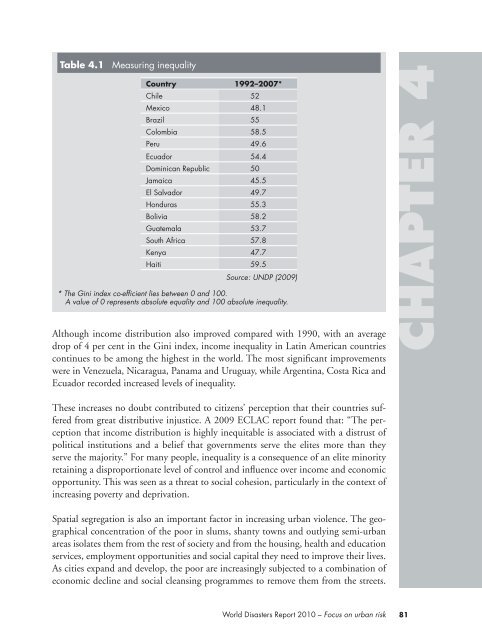World Disasters Report 2010 - International Federation of Red Cross ...
World Disasters Report 2010 - International Federation of Red Cross ...
World Disasters Report 2010 - International Federation of Red Cross ...
Create successful ePaper yourself
Turn your PDF publications into a flip-book with our unique Google optimized e-Paper software.
Table 4.1 Measuring inequality<br />
Country 1992–2007*<br />
Chile 52<br />
Mexico 48.1<br />
Brazil 55<br />
Colombia 58.5<br />
Peru 49.6<br />
Ecuador 54.4<br />
Dominican Republic 50<br />
Jamaica 45.5<br />
El Salvador 49.7<br />
Honduras 55.3<br />
Bolivia 58.2<br />
Guatemala 53.7<br />
South Africa 57.8<br />
Kenya 47.7<br />
Haiti 59.5<br />
Source : UNDP (2009)<br />
* The Gini index co-efficient lies between 0 and 100.<br />
A value <strong>of</strong> 0 represents absolute equality and 100 absolute inequality.<br />
Although income distribution also improved compared with 1990, with an average<br />
drop <strong>of</strong> 4 per cent in the Gini index, income inequality in Latin American countries<br />
continues to be among the highest in the world. The most significant improvements<br />
were in Venezuela, Nicaragua, Panama and Uruguay, while Argentina, Costa Rica and<br />
Ecuador recorded increased levels <strong>of</strong> inequality.<br />
These increases no doubt contributed to citizens’ perception that their countries suffered<br />
from great distributive injustice. A 2009 ECLAC report found that: “The perception<br />
that income distribution is highly inequitable is associated with a distrust <strong>of</strong><br />
political institutions and a belief that governments serve the elites more than they<br />
serve the majority.” For many people, inequality is a consequence <strong>of</strong> an elite minority<br />
retaining a disproportionate level <strong>of</strong> control and influence over income and economic<br />
opportunity. This was seen as a threat to social cohesion, particularly in the context <strong>of</strong><br />
increasing poverty and deprivation.<br />
Spatial segregation is also an important factor in increasing urban violence. The geographical<br />
concentration <strong>of</strong> the poor in slums, shanty towns and outlying semi-urban<br />
areas isolates them from the rest <strong>of</strong> society and from the housing, health and education<br />
services, employment opportunities and social capital they need to improve their lives.<br />
As cities expand and develop, the poor are increasingly subjected to a combination <strong>of</strong><br />
economic decline and social cleansing programmes to remove them from the streets.<br />
<strong>World</strong> <strong>Disasters</strong> <strong>Report</strong> <strong>2010</strong> – Focus on urban risk<br />
81

















